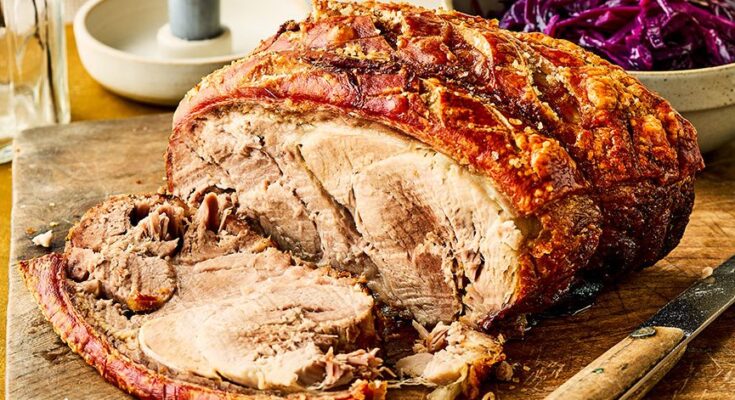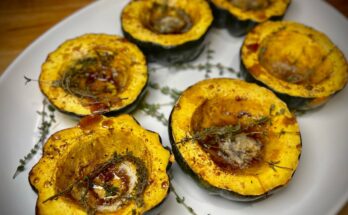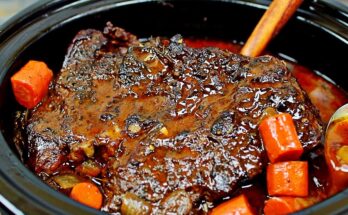Roast Pork Recipe: Roast pork isn’t just a dish—it’s a celebration of flavor, culture, and tradition. Across generations and continents, this dish has made its way to dinner tables, festive occasions, and casual weekend meals. The appeal? It’s incredibly versatile, richly flavored, and gives off an irresistible aroma that fills the entire house as it cooks. Whether you’re making a rustic Sunday lunch or an elegant holiday meal, roast pork always feels like the right choice.
What makes roast pork stand out from other meats is its ability to absorb flavors while maintaining a rich, juicy texture. Unlike other proteins, pork can be mild or bold, depending on the seasoning you use. From slow-roasting with herbs to searing and glazing, the methods to prepare it are endless—and that’s what makes it timeless.
Roast pork is also deeply rooted in cultural traditions. Think about Chinese char siu, Cuban lechón asado, or Italian porchetta—every culture has its unique spin on pork roasting. And the best part? Once you master the basic steps, it’s incredibly easy to adapt the recipe to your personal tastes.
Perfect Occasions to Serve Roast Pork
Roast pork is one of those magical dishes that fits into just about any event or gathering. Planning a cozy Sunday roast with family? Roast pork. Hosting a festive Christmas dinner? Roast pork. Need something crowd-pleasing for a potluck or celebration? You guessed it—roast pork.
What makes it such a favorite for special occasions is how easily it scales. You can make a small roast for two or go big with a shoulder roast for a dozen guests. It also holds heat well and even tastes better the next day, making it perfect for meal prepping or leftovers.
Another bonus? The presentation. A beautifully cooked pork roast with golden crispy skin or a caramelized glaze looks like it came straight out of a gourmet cookbook. Pair it with some roasted potatoes and steamed veggies, and you’ve got a meal that’ll impress anyone without a ton of effort.
List of Ingredients You’ll Need
Main Ingredients
Here’s what you’ll need to create a delicious, foolproof roast pork at home:
- Pork Roast (3 to 5 lbs) – Pork shoulder or pork loin are the most commonly used cuts. Shoulder is fattier and more flavorful, while loin is leaner and cooks faster.
- Garlic (4–6 cloves, minced) – Adds depth and sharpness to balance the richness of pork.
- Olive Oil (2–3 tablespoons) – Helps in browning and crisping up the skin.
- Salt (1–2 teaspoons) – Essential for seasoning and drawing out moisture to make the skin crispy.
- Black Pepper (1 teaspoon) – Enhances the flavor profile and adds a slight kick.
You can easily find these ingredients at any grocery store, and they serve as the foundation for countless roast pork variations.
Seasonings and Spices
The beauty of roast pork lies in its seasoning. The right blend can elevate a simple cut of meat into something truly spectacular:
- Rosemary (1 tablespoon, chopped) – Pairs beautifully with pork and brings an earthy note.
- Thyme (1 tablespoon) – Adds a subtle lemony touch.
- Paprika (1 teaspoon) – Brings color and a hint of smokiness.
- Fennel Seeds (optional, ½ teaspoon) – Perfect for Italian-style roast pork.
- Cumin or Coriander (½ teaspoon) – Great for a spiced, exotic flavor.
These spices can be adjusted to your taste. Want it more herbaceous? Add sage. Prefer some heat? Toss in chili flakes.
Optional Add-ins for Extra Flavor
Want to take your roast pork to the next level? Consider these flavor-boosting additions:
- Onions (sliced into wedges) – Lay them under the pork to create a natural roasting rack.
- Apples or Pears (quartered) – Their natural sweetness complements the savory pork.
- White Wine or Apple Cider (½ cup) – Adds moisture and complexity during roasting.
- Honey or Brown Sugar (1 tablespoon) – For a lightly glazed, sweet-savory profile.
These add-ins don’t just enhance flavor—they also create incredible pan drippings you can turn into gravy or sauce.
Tools and Kitchen Equipment Needed
Must-Have Utensils
To execute the perfect roast pork, having the right tools is just as important as the ingredients:
- Roasting Pan with Rack – Elevates the pork so hot air can circulate evenly.
- Meat Thermometer – Crucial for making sure your pork is cooked to safe temperatures (145°F or 63°C).
- Sharp Chef’s Knife – For precise cutting and carving.
- Cutting Board – Use a sturdy one with grooves to catch juices.
- Mixing Bowl – For combining marinades or spice rubs.
Using proper tools not only makes cooking easier but also ensures a more professional finish to your dish.
Optional but Helpful Tools
- Blender or Food Processor – If you’re making a complex marinade or glaze.
- Basting Brush – For applying oil, butter, or glaze while roasting.
- Tongs – To handle the hot pork safely and efficiently.
- Aluminum Foil – Essential for resting the meat and retaining moisture.
Having these tools on hand makes the process smoother, especially if you’re aiming to impress guests or experiment with recipe variations.
Preparation Before Cooking
Choosing the Right Cut of Pork
Selecting the ideal cut is the first big step toward a successful roast. Pork shoulder, pork loin, and pork belly are top contenders, each offering different textures and flavors:
- Pork Shoulder (a.k.a. Boston Butt) – Marbled with fat, making it tender and juicy when slow-roasted. Ideal for longer cooking times.
- Pork Loin – Lean and cooks faster; best for quicker roasts or if you want less fat.
- Pork Belly – Rich and indulgent, perfect for crispy skin lovers.
Your choice depends on the flavor and texture you’re aiming for. Pork shoulder for succulent pulls, loin for a classic roast, or belly for decadence.
Cleaning and Prepping the Meat
Once you’ve chosen your cut, rinse it under cold water and pat it completely dry with paper towels. Moisture is the enemy of crispy skin.
Next, trim any excess fat (but not all of it—fat = flavor). Score the skin with a sharp knife in a criss-cross pattern. This helps the seasoning penetrate and allows the skin to puff up and crisp in the oven.
Rub the pork generously with olive oil, salt, and your chosen spices. If you’re using garlic, make small incisions in the meat and insert slivers inside. This adds bold, garlicky flavor to every bite.
Marinating for Maximum Flavor
Letting your pork marinate isn’t required, but it’s definitely worth the wait. Marinate it for at least 2 hours, but overnight in the fridge is ideal.
Use a marinade of olive oil, garlic, herbs, and your favorite seasonings. For an extra tender roast, you can even brine it in a saltwater solution with spices for 8–12 hours.
Cover the pork with plastic wrap or seal it in a ziplock bag to prevent cross-contamination. Place it in a bowl or dish in the fridge, and let those flavors soak deep into the meat fibers.
Step-by-Step Guide to Cooking Roast Pork
Step 1 – Preheating the Oven
Start by preheating your oven to 375°F (190°C). A properly heated oven ensures the pork cooks evenly and develops a beautiful, golden-brown crust. While the oven heats, line your roasting pan with foil or set a rack inside for better air circulation and easier cleanup.
Step 2 – Searing the Pork (Optional but Flavorful)
If you want a deeper, richer flavor, sear the pork before roasting. Heat a bit of oil in a large skillet over medium-high heat and brown the pork on all sides until golden. This caramelizes the surface, adding a layer of savory complexity that takes your roast to the next level.
Step 3 – Roasting the Pork
Transfer the pork to the roasting pan. Season generously with salt, pepper, garlic, herbs, or your favorite spice rub. Roast in the preheated oven until the internal temperature reaches 145°F (63°C) for tender, juicy meat — usually about 25–30 minutes per pound. If you love crispy crackling, increase the heat to 425°F (220°C) during the last 10–15 minutes.
Step 4 – Letting It Rest
Once the roast is done, remove it from the oven and let it rest on a cutting board for 10–15 minutes. This resting period allows the juices to redistribute throughout the meat, keeping it moist and flavorful when sliced.
Step 5 – Carving and Serving
Slice the roast carefully using a sharp knife, cutting against the grain for maximum tenderness. Serve it warm with roasted vegetables, mashed potatoes, or a drizzle of pan gravy. The result is pure perfection — crispy on the outside, juicy inside, and bursting with roasted goodness.
Tips for a Perfect Roast Pork
Common Mistakes to Avoid
- Skipping the Thermometer: Guessing the doneness can lead to dry or undercooked meat. Always check internal temp.
- Not Letting It Rest: Cutting too early lets all the juices escape. Let it rest!
- Overcooking: Pork is best when juicy. Don’t let it go past 160°F unless you’re going for pulled pork.
- Not Scoring the Skin: If you want crackling, you must score and salt the skin generously.
- Using a Cold Roast: Let the meat sit at room temp for 30 minutes before roasting for even cooking.
How to Get Crispy Skin
If you’re aiming for that ultra-satisfying crispy skin, follow these golden rules:
- Dry the skin completely before seasoning.
- Score the skin with a sharp knife—but not too deep.
- Salt generously. Salt helps pull moisture out of the skin.
- Start with high heat. Blast the roast at 450°F (230°C) for the first 20 minutes.
- Finish with high heat again for the final 10 minutes.
And here’s a bonus tip: if your roast is done but the skin isn’t crispy, remove the pork and broil the skin side under the grill for 2–3 minutes. Watch it closely to prevent burning.
Delicious Side Dishes to Pair With Roast Pork
Vegetables That Complement Roast Pork
Roast pork is rich, savory, and sometimes slightly sweet—making it the perfect centerpiece for a well-rounded meal. But what takes it to the next level? The side dishes, of course! Pairing roast pork with the right vegetables enhances the dish and brings balance to your plate.
Here are some of the top vegetable sides that pair beautifully with roast pork:
- Roasted Root Vegetables – Think carrots, parsnips, sweet potatoes, and beets. Roast them alongside your pork for a delicious, caramelized texture.
- Brussels Sprouts – Roasted until crispy with a little balsamic glaze? Yes, please.
- Green Beans Almondine – Light, buttery, and slightly crunchy. A great contrast to tender pork.
- Sautéed Spinach or Kale – Add garlic and olive oil, and you’ve got a nutrient-packed side that cuts through the richness of the meat.
- Cabbage (Braised or Roasted) – A traditional pairing in many European cuisines. Add apple slices for a hint of sweetness.
Not only do these vegetables enhance flavor, but they also bring texture, color, and freshness to your meal—making every bite more enjoyable.
Starches and Grains That Work Well
What’s roast pork without something hearty to go with it? The richness of the pork needs a solid base to balance things out. Here are some of the best starchy sides and grains to serve with roast pork:
- Mashed Potatoes – Creamy, buttery, and perfect for soaking up pork juices or gravy.
- Roasted Potatoes – Crispy on the outside, fluffy inside. Season with rosemary and garlic for an unbeatable side.
- Rice Pilaf or Wild Rice – Earthy flavors pair beautifully with pork, especially when mixed with nuts or dried fruit.
- Polenta – Creamy, cheesy polenta is a dreamy partner to roast pork, especially with a herb-infused sauce.
- Macaroni and Cheese – Comfort food meets comfort food. A crowd-pleasing combo that never fails.
If you want something lighter, try quinoa or couscous with herbs and lemon zest. These sides soak up flavor without overwhelming the star of the show—your roast pork.
How to Store and Reheat Leftovers
Safe Storage Practices
One of the best things about roast pork is that it makes amazing leftovers. But you’ve got to store it right to keep it safe and delicious.
Here’s how:
- Let it cool for about 30 minutes after serving (but no longer than 2 hours).
- Wrap tightly in foil or plastic wrap, or place in an airtight container.
- Refrigerate immediately. Roast pork will stay good in the fridge for 3–4 days.
- Freeze for longer storage. Use freezer bags or vacuum-sealed packs, and label them with the date. It’ll last up to 3 months in the freezer.
If your pork has a crispy skin, be aware that it might soften in the fridge. But don’t worry—you can revive that crackling when reheating.
Best Reheating Methods
Reheating roast pork isn’t hard, but you want to do it right to avoid dryness. Here’s how to bring it back to life:
- Oven Method (Best Overall): Preheat your oven to 325°F (160°C). Place the pork in a baking dish, add a splash of broth or water, cover with foil, and heat for 15–20 minutes.
- Stovetop Method: Slice pork thinly and reheat in a skillet with a little olive oil or butter. This keeps it juicy and flavorful.
- Microwave (Quickest): Use a microwave-safe dish, cover loosely, and heat in 30-second intervals to avoid overcooking.
- Air Fryer (For Crispy Skin): This works wonders if you’re trying to bring back the crunch. Heat at 375°F for a few minutes until crisp.
Avoid reheating multiple times, as this can make the pork dry and rubbery. Only reheat what you plan to eat, and enjoy!
Nutritional Information of Roast Pork
Calories and Macronutrient Breakdown
Roast pork isn’t just delicious—it can also be part of a balanced diet, depending on how you prepare it. Here’s a general idea of what you’re consuming per 100g of roast pork (without skin or extra fat):
- Calories: ~250 kcal
- Protein: 25–28g
- Fat: 15–18g
- Carbohydrates: 0g
- Fiber: 0g
If you’re trimming excess fat and avoiding sugary glazes, roast pork becomes a great source of lean protein with healthy fats.
Health Benefits and Considerations
Roast pork offers several nutritional perks:
- High in Protein: Essential for muscle repair and immune function.
- Rich in B Vitamins: Especially B12 and B6, which support energy metabolism and brain health.
- Iron and Zinc: Important for oxygen transport and immune system support.
However, it’s wise to be mindful of the fat content, especially if you’re using fatty cuts like pork belly. If you’re watching your sodium intake, reduce salt in the rub and avoid processed sides.
Want to make it healthier? Pair it with steamed vegetables, skip the sugary glaze, and choose leaner cuts like tenderloin or loin.
Variations of Roast Pork Recipes
Asian-Inspired Roast Pork
Asian cuisine offers some of the most flavorful and visually striking versions of roast pork. One standout? Chinese Char Siu—also known as Chinese BBQ pork. It’s sweet, savory, slightly sticky, and sports that unmistakable reddish glaze.
Key ingredients:
- Hoisin sauce
- Soy sauce
- Chinese five spice
- Honey or brown sugar
- Red food coloring (optional, for that signature look)
- Garlic and ginger
The pork is marinated for several hours (or overnight), then roasted until caramelized and tender. This variation is perfect for serving with rice, steamed buns, or noodle dishes.
Another great Asian version is Filipino Lechon Kawali—crispy pork belly that’s been boiled, seasoned, then deep-fried. Though not oven-roasted, it uses the same core principles: crisp skin, juicy meat, and bold flavors.
Mediterranean-Style Roast Pork
If you love garlic, herbs, and olive oil, the Mediterranean-style roast pork might become your new favorite. Think Italian Porchetta—a seasoned pork belly (sometimes wrapped around loin) rolled tightly and roasted until golden and crispy on the outside and deeply herby inside.
Key flavors include:
- Fennel seeds
- Garlic
- Rosemary
- Thyme
- Lemon zest
- Olive oil
This version is perfect for serving with roasted vegetables, polenta, or crusty bread. The fragrance of herbs and citrus makes every bite refreshing yet hearty.
Greek-inspired pork roasts are also popular and usually include oregano, lemon juice, garlic, and sometimes a yogurt-based marinade for extra tenderness.
Sweet and Savory Glazed Roast Pork
This version of roast pork is all about balance—pairing salty and umami-rich pork with a sugary glaze that caramelizes beautifully during roasting. It’s a hit at holiday dinners and Sunday roasts.
Popular glaze ingredients:
- Honey or maple syrup
- Dijon or whole-grain mustard
- Balsamic vinegar
- Brown sugar
- Apple cider
- Pineapple or orange juice
The trick is to glaze the roast during the last 20–30 minutes of cooking. This prevents the sugars from burning and gives the outside a glossy, flavorful crust. Sweet and savory roast pork is best paired with starchy sides like mashed potatoes, stuffing, or rice.
FAQs about Roast Pork Recipe
Can I use boneless pork for roasting?
Absolutely! Boneless pork loin or shoulder works great and is easier to slice and serve. Just remember, boneless cuts cook slightly faster, so monitor the temperature closely to avoid overcooking.
How do I know when the pork is done?
Use a meat thermometer to check the internal temperature. Pork is safely cooked at 145°F (63°C). Let it rest after cooking, and the temperature will rise slightly while retaining juices.
What’s the best way to keep roast pork juicy?
Don’t overcook it! Also, marinating the pork, using a meat thermometer, and letting it rest after roasting are essential for juicy, flavorful meat.
Can I marinate the pork overnight?
Yes, marinating overnight enhances the flavor dramatically. Use a ziplock bag or airtight container, and keep it in the fridge. The longer it sits, the deeper the seasoning will go.
What should I do with the pan drippings?
Don’t waste them! You can make a simple and delicious gravy by deglazing the pan with wine or broth, adding a touch of flour or cornstarch to thicken, and seasoning to taste.
Conclusion
Roast pork is more than just a dish—it’s an experience. From the moment you choose your cut, to seasoning it with your favorite herbs and spices, to that satisfying “crunch” when slicing into crispy skin, it’s a journey of flavor, tradition, and creativity. Whether you stick to a classic garlic-herb combo or explore exotic glazes and cultural twists, roast pork gives you room to experiment and wow your guests every time.
Remember: choosing the right cut, seasoning well, monitoring the internal temperature, and letting it rest are key to pork perfection. With this step-by-step guide, you now have everything you need to master roast pork like a pro—whether you’re cooking for two or feeding a hungry crowd.
Ready to roast? Fire up that oven and bring this show-stopping dish to life in your kitchen.



